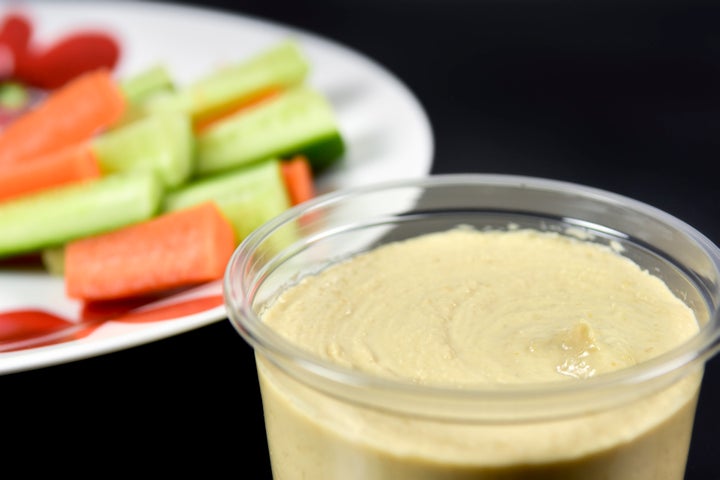Many shop-bought dips, which are perceived as being healthier alternatives to crisps and chocolate, are actually laden with salt and fat.
A new report by Consensus Action on Salt and Health (CASH) found that some houmous dips contain as much salt as four packets of ready salted crisps.
Researchers looked at 210 chilled dips across all major supermarket chains including houmous, guacamole, salsa and taramasalata.
Houmous was flagged on more than one occasion for containing large quantities of salt and fat, while taramasalata turned out to be the saltiest dip.
“Once again we demonstrate the unnecessary amounts of salt and fat being added by the food industry to what could be a healthy product,” said Professor Graham MacGregor from Queen Mary University, London, and chairman of CASH.
He added that a diet high in salt leads to strokes and heart disease.

Examples of products with high levels of salt per 100g include:
- Tesco Caramelised Onion Houmous - 1.6g
- Sabra Baba Ganoush - 1.6g
- Marks and Spencer Caramelised Onion Houmous - 1.53g
- Marks and Spencer Taramasalata - 1.5g
- Moorish Baba ghanoush-ish Aubergine Smoked dip – 1.4g
Examples of products with lower levels of salt per 100g:
- Essential Waitrose Reduced Fat Sour Cream & Chive Dip - 0.25g
- The Co-operative Salsa - 0.3g
- Tesco Tzatziki - 0.4g
- Waitrose Creamy & Refreshing Guacamole - 0.4g
- Lidl Red Pepper Houmous - 0.43g
According to the report, the most commonly sold dip is houmous, yet it is far from the healthiest with a staggering 74% having a red front-of-pack label for fat and not one single product providing a green front-of-pack label for salt.
The dip, made predominantly from chickpeas, also contains on average 280 calories per 100g – more than 10% of the recommended daily intake for women.
One of the saltiest houmous dips was Marks & Spencer’s Caramelised Onion Houmous, which contains more salt per 100g (1.53g) than four packets of ready salted crisps and over a quarter of the daily maximum recommended intake for salt.
Of all the dips surveyed, taramasalata was the saltiest overall with an average salt content of 1.25g per 100g compared to salsa which was the least salty (0.49g per 100g).
A serving of ASDA’s taramasalata contains the same amount of salt as 13 Ritz crackers.
There was also a large variation in salt content within the same dip category. For example the salt content in houmous dips ranged from 0.43g per 100g in Lidl’s Red Pepper Houmous to 1.6g per 100g in Tesco’s Caramelised Onion Houmous.
Over one fifth (23%) of dips had a red front of pack label for saturated fat content.
Alarmingly, a 57.5g portion of Waitrose Cheese and Chive dip (roughly one quarter of a tub) was found to contain more total fat than a Big Mac.
“Food companies need to take action and reduce both the salt and fat content in dips,” said Sonia Pombo, nutritionist and campaign manager for CASH.
“The variation of different products revealed in our survey shows it can be achieved, which is why it’s equally important that we as individuals read the label carefully and opt for healthier brands.”
Professor Graham MacGregor added: “Reducing salt is the most cost effective measure to reduce the number of people suffering, which is why it is imperative the government announce a new robust plan for reducing salt in our diet. “
CASH has since listed some helpful tips and tricks for reducing salt consumption in your diet:
1. Be label savvy and don’t be fooled by products branded as low/reduced fat – whilst the fat content may be lower the salt content may still be high! Take an extra moment to check the label and compare a few different ones before making your selection.
2. Choose dips with less fat and salt, like salsa, or a vegetable-based dip, rather than sour-cream or cheese-based dips which are higher in fat and saturates.
3. Be wary of portion sizes – eating straight out of the container will most likely lead to overconsumption, so spoon some out on your plate instead and fill it with healthier treats e.g. salad and fruit. Individual single-serve pots can be a good way to control portions.
4. Eat dips with vegetables rather than salty and high fat foods like crisps or cheese.
5. Get creative and make your own – that way you can control what you put in! Some plain low-fat yogurt, cucumber and a sprig of mint can make for a tasty homemade tzatziki, or make your own chunky salsa with some tomatoes, onion, chilli and fresh herbs.